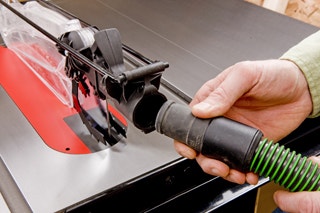Is a Pilot Light Safe in My Shop?
My tools have outgrown my small shop. I want to move my woodworking shop into my two-car garage; however, my gas water heater is also in the garage. I understand that airborne wood dust is flammable and may be an issue with the water heater pilot light. Will this be a dangerous mix? Do you have any suggestions for a solution? - Bryan Croft
Chris Marshall: Pilot lights and wood dust or finishing fumes aren't a good mix. While some will argue that the risk of an explosion is small from an open pilot light, it's still a viable possibility if the concentration of fine dust or volatile fumes is high enough. My first suggestion for you is to buy a copy of Sandor Nagyszalanczy's book, Woodshop Dust Control. Sandor is an expert on the subject of how to manage wood debris and dust, and his book addresses not only the issue of fire safety but also how to make our shops cleaner, healthier places to work in general. Sandor suggests that, as an overall dust control strategy, we should try to collect dust at the source whenever possible - using a shop vac or a central dust collection system attached to our machines. Downdraft sanding tables can help control sanding dust, and so can opening your garage door to draw out the dusty or fume-filled air and exchange it for fresh. He also recommends adding an air filtration device - often hung from the ceiling - to help reduce the really fine airborne dust when you can't open the big door. You could switch to an electric water heater and eliminate the flame altogether, but that's probably not what you want to hear. If it were me, I'd take my big sanding jobs outside when the weather permits; that's where the lion's share of the fine dust comes from, but keep in mind that the table saw and band saw are also big dust culprits. On a nice dry day, you can do the same with finishing to keep the hazardous fumes away from that flame. I'd get my machines hooked up to a dust collector as soon as possible, or at least move your dust-producing machines close to the garage door so you can open it when you're sawing. Woodworking is so much more pleasant when you're not coughing and sneezing or walking around in a hazy cloud of dust. Who needs that?!
Tim Inman: The dust is certainly a flammability concern, but the solvents you might be using are an even greater one.
Nearly all solvents we typically use in woodworking and finishing create flammable vapors that are heavier than air. They will fall and settle to the floor. This is why water heaters classically cause fires in shops. The vapors are down low where your nose isn't - so you don't smell the building concentration. Today, many heaters don't have pilot lights, so little fires are less likely. Instead, WHOMPF! When the heater fire kicks on, a big vapor pocket ignites. Don't be fooled into thinking that you can use water-based finishes and escape the hazards of workshop fires, either. The vapors they give off may not be so flammable (there are some flammable solvents in water-based products, by the way), but the dried dust that remains from spraying or sanding those finishes will burn like crazy!
My best advice: Do not put a shop anywhere near an open flame, especially when that flame is low to the floor. I don't even like using an alcohol burner to do my shellac stick burn-ins anymore. If the water heater can't be moved, then consider building it into a fireproof room. Be safe.
Keep the inspiration coming!
Subscribe to our newsletter for more woodworking tips and tricks

